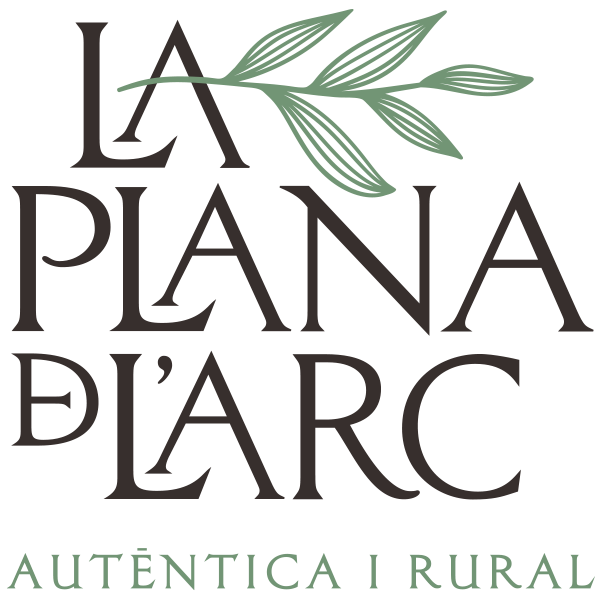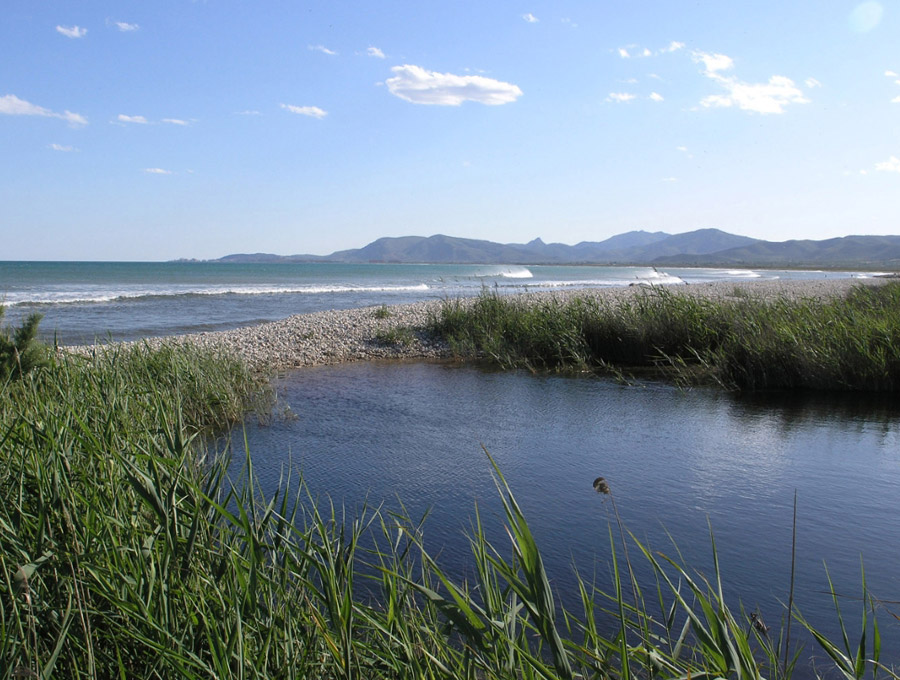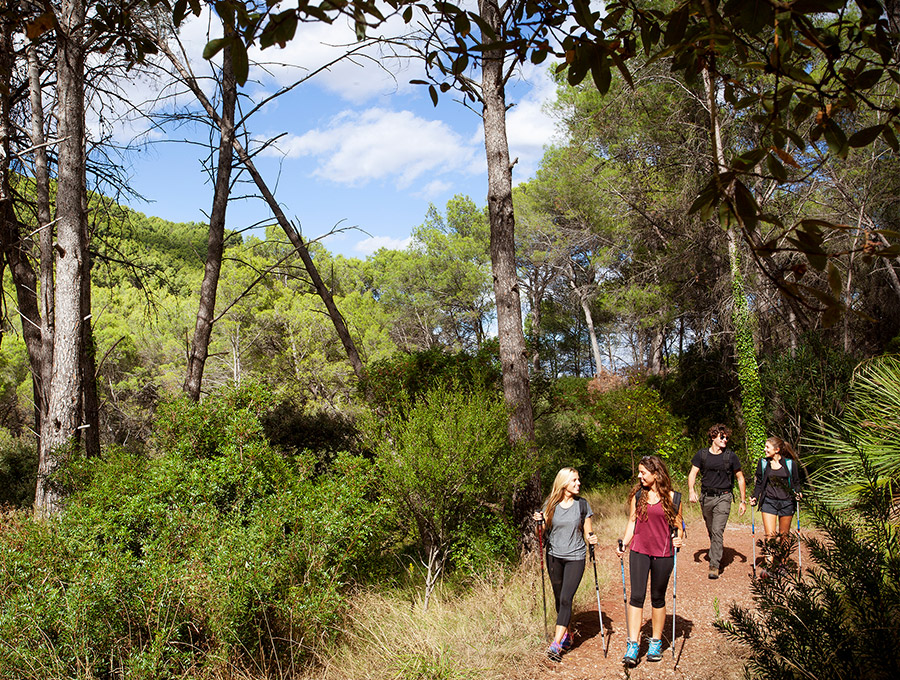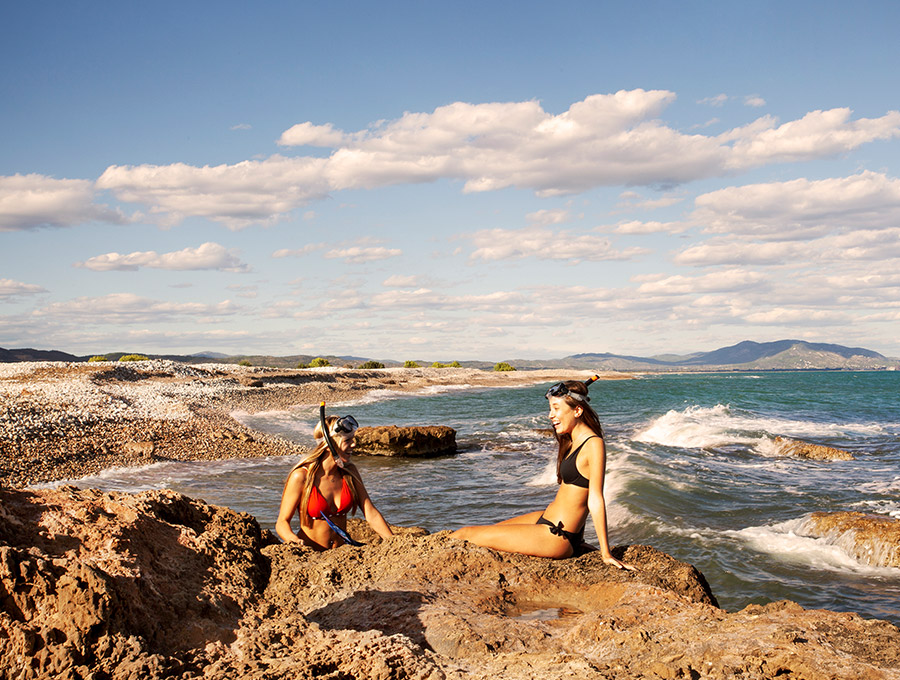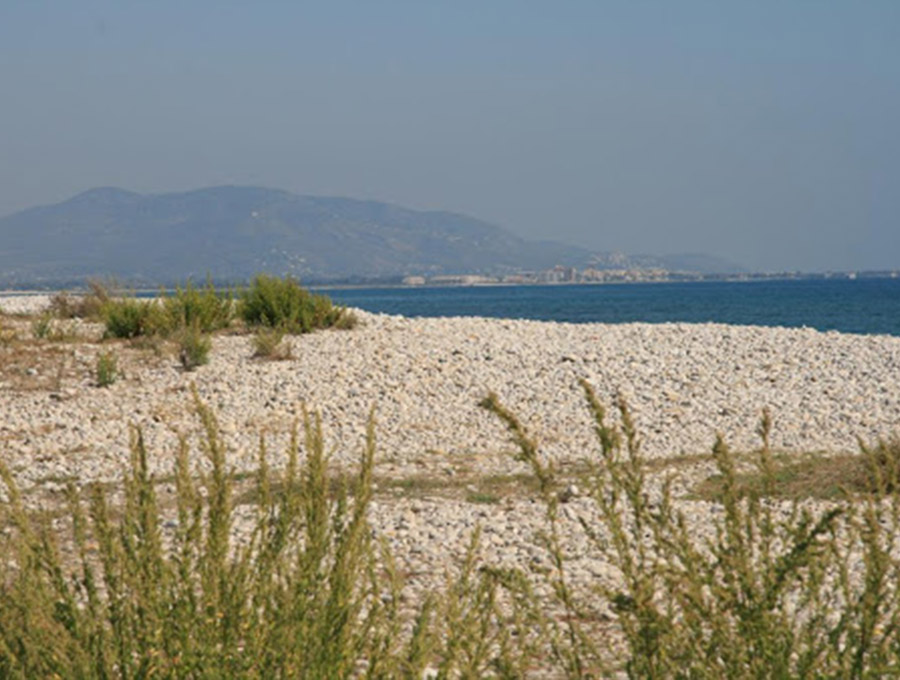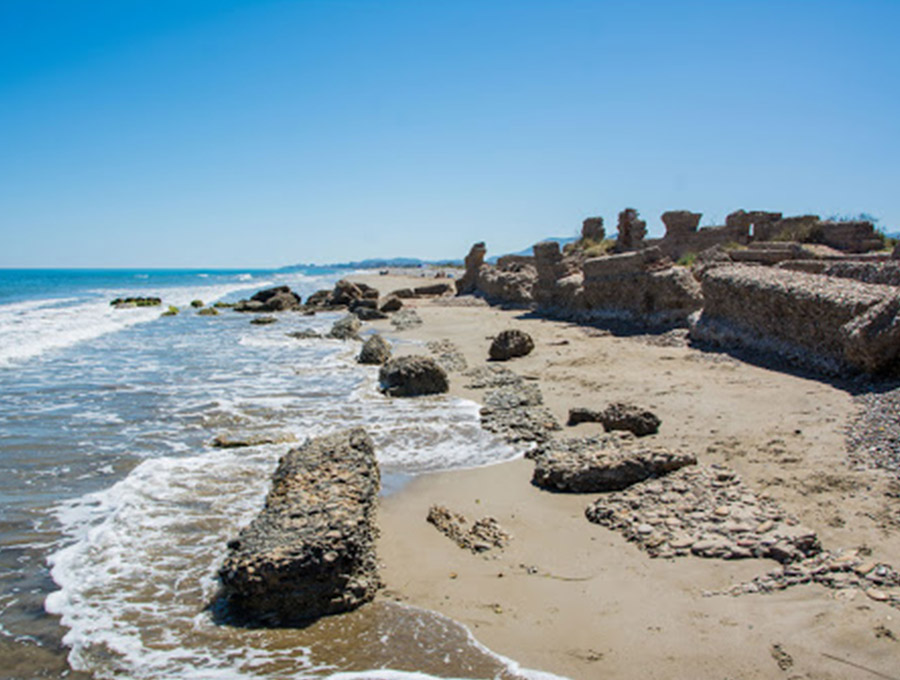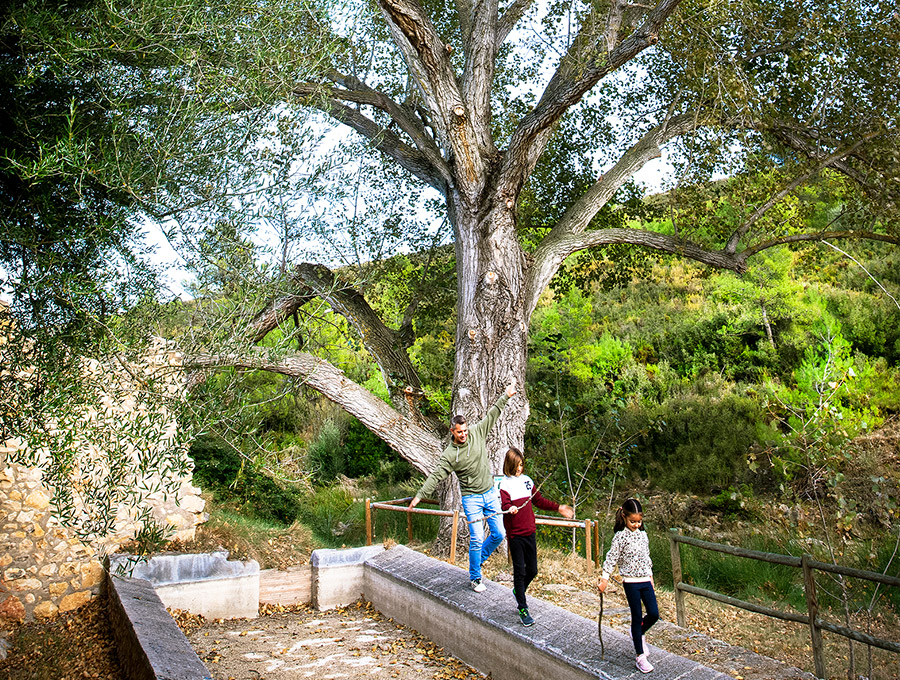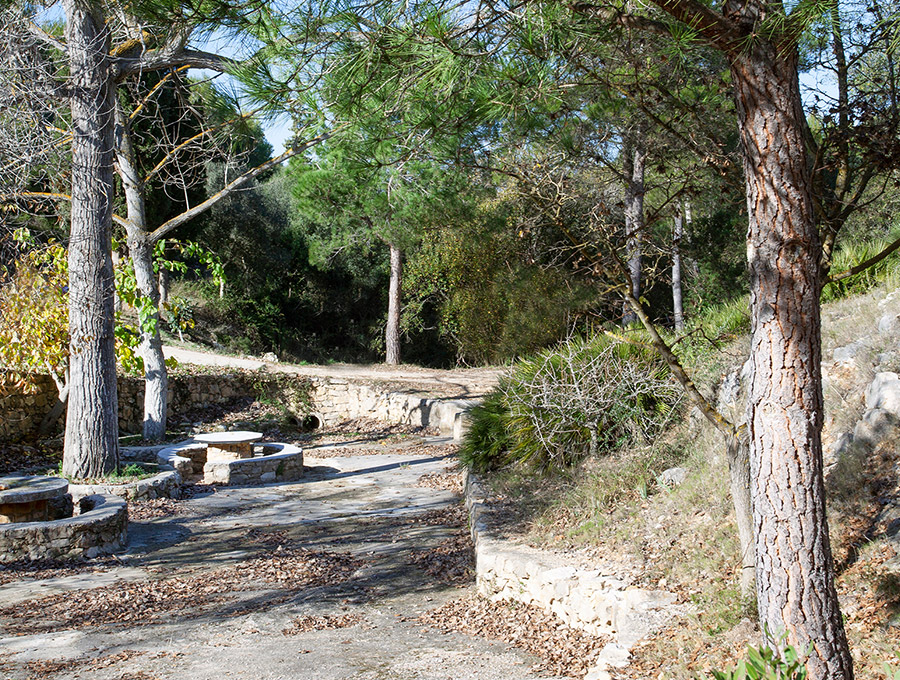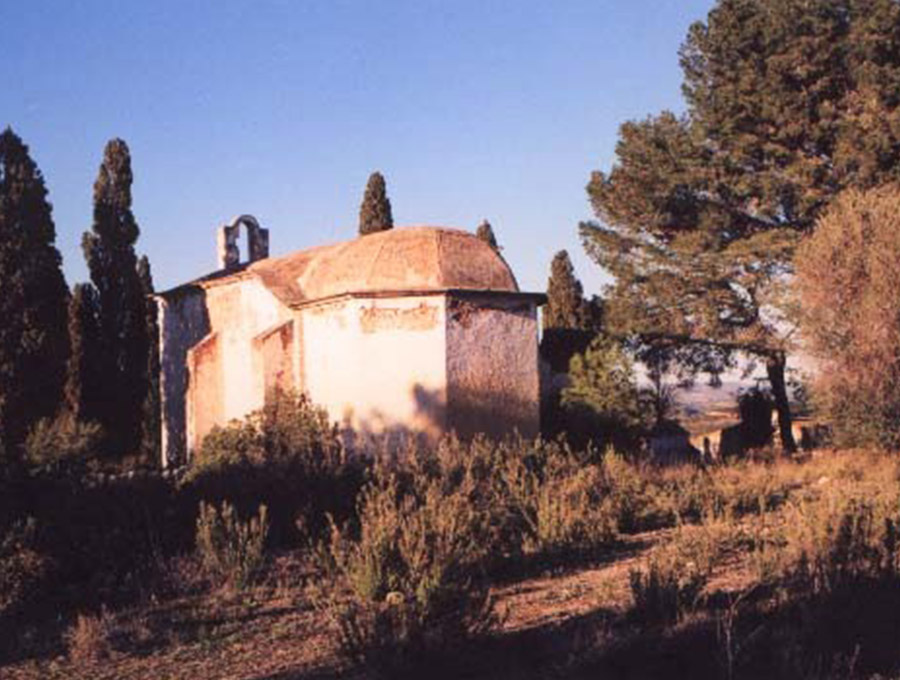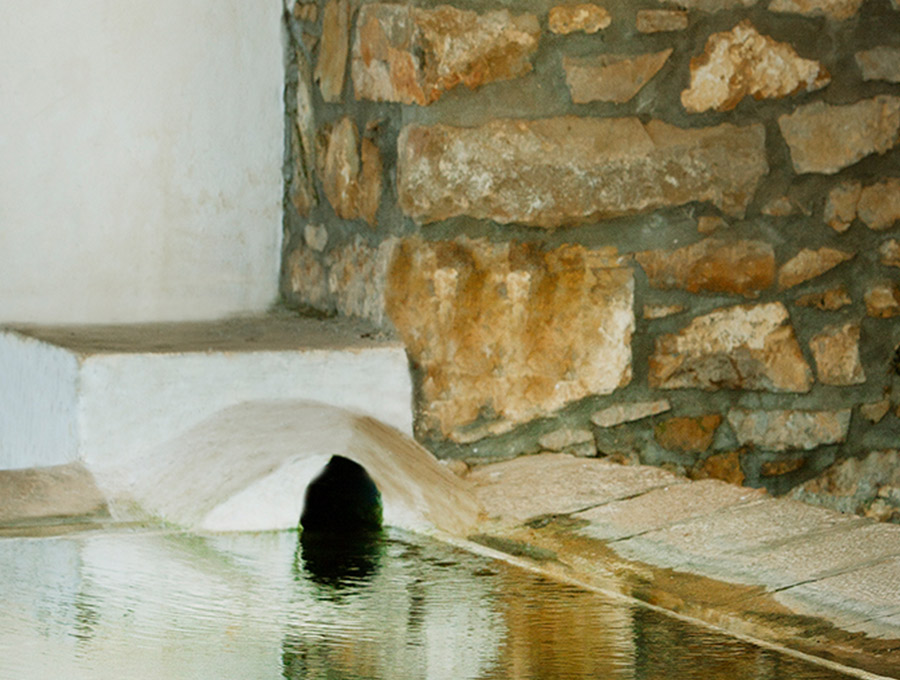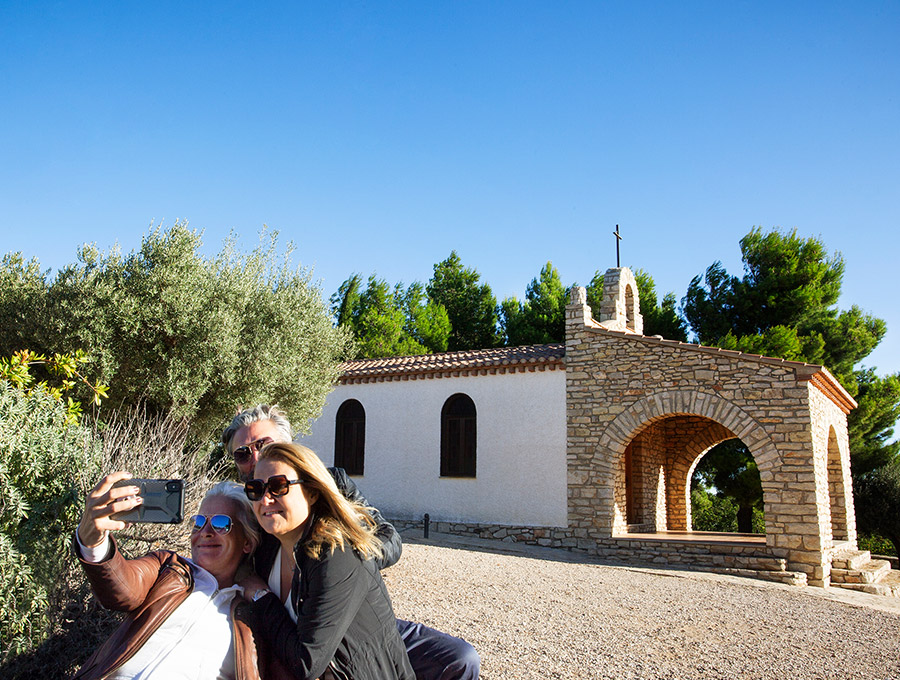Plana de l’Arc
countryside spots
Prat de Cabanes-Torreblanca Nature Reserve (Cabanes)
It is impossible not to fall in love with the blue of Cabanes Nature Reserve! El Prat de Cabanes – Torreblanca is a narrow coastal strip of salt marshes and shaped marshland. It is the main wetland area in the province of Castelló. Its special landscape, geological and ecological characteristics make it of great value in the context of Valencian natural heritage. Its importance has been recognised on a global scale with the inclusion of the site on the List of Wetlands of International Importance.
Desert de les Palmes Nature Reserve (Cabanes)
The vegetation in these mountains is undoubtedly the most abundant in the whole area. So why is it called a desert? The explanation is historical and nothing to do with the landscape. In 1697, a community of monks settled there in what they called ‘deserts’, places far from the hustle and bustle of the world. Centuries later, a walk through this nature reserve nestled in a coastal mountain range in the Plana Alta region, parallel to the coast, with abundant crests and rocky outcrops, whose highest peak is El Bartolo at 729 m, continues to offer the calm of beauty and peace.
Prat de Cabanes-Torreblanca Nature Reserve (Cabanes)
It is impossible not to fall in love with the blue of Cabanes Nature Reserve! El Prat de Cabanes – Torreblanca is a narrow coastal strip of salt marshes and shaped marshland. It is the main wetland area in the province of Castelló. Its special landscape, geological and ecological characteristics make it of great value in the context of Valencian natural heritage. Its importance has been recognised on a global scale with the inclusion of the site on the List of Wetlands of International Importance.
Desert de les Palmes Nature Reserve (Cabanes)
The vegetation in these mountains is undoubtedly the most abundant in the whole area. So why is it called a desert? The explanation is historical and nothing to do with the landscape. In 1697, a community of monks settled there in what they called ‘deserts’, places far from the hustle and bustle of the world. Centuries later, a walk through this nature reserve nestled in a coastal mountain range in the Plana Alta region, parallel to the coast, with abundant crests and rocky outcrops, whose highest peak is El Bartolo at 729 m, continues to offer the calm of beauty and peace.
Desert de les Palmes Nature Reserve (Cabanes)
The vegetation in these mountains is undoubtedly the most abundant in the whole area. So why is it called a desert? The explanation is historical and nothing to do with the landscape. In 1697, a community of monks settled there in what they called ‘deserts’, places far from the hustle and bustle of the world. Centuries later, a walk through this nature reserve nestled in a coastal mountain range in the Plana Alta region, parallel to the coast, with abundant crests and rocky outcrops, whose highest peak is El Bartolo at 729 m, continues to offer the calm of beauty and peace.
Torre la Sal Beach (Cabanes)
This beach in Cabanes preserves all the charm of its fishing past with the traditional fishermen’s houses standing among sand and gravel. Four defence towers stand out in the area, notably including the one it is named after, La Sal Tower. The cleanliness of its waters has led to the construction of a Marine Biology Research Centre and the Prat de Cabanes-Torreblanca Nature Reserve Information Centre.
La Moreria and Riu de Sant Miquel (Les Coves de Vinromà)
There are landscapes that are messengers of civilisations, caretakers of nature and ambassadors of time. This site is one of them. Its telluric beauty has dazzled the world for being the cradle of civilisations, for its cave paintings, for the Moorish constructions and for a rich flora of full of contrasts thanks to the river. This was the stage for an event that marked the town’s recent history.
+
A girl named Raquel claimed that the Virgin Mary had appeared to her in Campana de la Morería cave. This news spread quickly along with the young girl’s prediction that on 1 December a great event would take place: at three o’clock in the afternoon, the day would turn to night and miracles would fill the land. Nothing happened on the appointed date… However, who knows what secrets still lie within these rocks?
-
La Moreria and Riu de Sant Miquel (Les Coves de Vinromà)
There are landscapes that are messengers of civilisations, caretakers of nature and ambassadors of time. This site is one of them. Its telluric beauty has dazzled the world for being the cradle of civilisations, for its cave paintings, for the Moorish constructions and for a rich flora of full of contrasts thanks to the river. This was the stage for an event that marked the town’s recent history.
+
A girl named Raquel claimed that the Virgin Mary had appeared to her in Campana de la Morería cave. This news spread quickly along with the young girl’s prediction that on 1 December a great event would take place: at three o’clock in the afternoon, the day would turn to night and miracles would fill the land. Nothing happened on the appointed date… However, who knows what secrets still lie within these rocks?
-
Valltorta Ravine – World Heritage Site (Les Coves de Vinromà)
You will fall in love with this natural temple, devoted to the mother rock that protects art. Declared a World Heritage Site in 1998, the ravine runs through the municipalities of Tírig, Albocàsser and Les Coves.
+
Among the various shelters and caves, the most outstanding collection of paintings is in Cova de la Saltadora cave, which is more than 200 m long and contains 150 figures. These cave paintings are unique in both style and subject matter. Hunting scenes, animals, archers and female figures can be seen, reflecting everyday scenes from the life of the people who inhabited the area thousands of years ago.
-
Assut countryside spot (Vilanova d’Alcolea)
This spot, surrounded by large poplars and white elms, is in the Hostalot district, near Via Augusta and Ildum. Its name “Assut” comes from a type of water barrier in the area. “Assut” actually means “sluice”, i.e. a place where a stone barrier was created so that water accumulated between the “Carrasqueta” ravine and the Vilanova River.
+
The area around the “Assut” site, next to a stretch of the Vilanova River (“Barranc de les Passeres”), was declared a Wildlife Reserve in 2015, as its waters contain some species of amphibians that are unique in Europe. “Xop de l’Assut” was declared a Monumental Tree, in accordance with Valencian Government Act 4/2006 of 19 May on Monumental Tree Heritage in the Valencian Community. A place not to be missed.
-
Assut countryside spot (Vilanova d’Alcolea)
This spot, surrounded by large poplars and white elms, is in the Hostalot district, near Via Augusta and Ildum. Its name “Assut” comes from a type of water barrier in the area. “Assut” actually means “sluice”, i.e. a place where a stone barrier was created so that water accumulated between the “Carrasqueta” ravine and the Vilanova River.
+
The area around the “Assut” site, next to a stretch of the Vilanova River (“Barranc de les Passeres”), was declared a Wildlife Reserve in 2015, as its waters contain some species of amphibians that are unique in Europe. “Xop de l’Assut” was declared a Monumental Tree, in accordance with Valencian Government Act 4/2006 of 19 May on Monumental Tree Heritage in the Valencian Community. A place not to be missed.
-
Font de Calaf countryside spot (Vilanova d’Alcolea)
This geography will be engraved on your memory with the remembrance of the sound of water dancing. Located in the “Mas de Calaf” area. It is a very beautiful spot with one of the best springs with very high quality water, barbecue facilities and stone tables under magnificent black poplars.
El Quartico (Benlloc)
El Quartico, considered a historical-cultural heritage site, was inhabited from shortly after the Reconquest (1245), and has been uninhabited since 1960. Located at an altitude of 237 metres above sea level, it is nestled deep in the mountainous area of the municipality. This district has several architectural buildings of cultural interest.
+
We begin at the Calvary, a plot of land with a neo-Gothic hermitage and seven chapels in which the different stages of Christ’s crucifixion are painted. Here there are spectacular views of the Prat Torreblanca-Cabanes countryside and the sea. We continue with the mixed school built during the Second Republic and divided into two parts: the classroom and the teacher’s house. There is also a horse mill, known in other parts of Spain as an olive oil mill, where the olives were pressed to obtain oil through animal traction in the milling process. It was built in 1743. Finally, you can also visit an oven, built in 1680 of stone and lime mortar and solid ceramic bricks covered with Arabic tiles.
-
El Quartico (Benlloc)
El Quartico, considered a historical-cultural heritage site, was inhabited from shortly after the Reconquest (1245), and has been uninhabited since 1960. Located at an altitude of 237 metres above sea level, it is nestled deep in the mountainous area of the municipality. This district has several architectural buildings of cultural interest.
+
We begin at the Calvary, a plot of land with a neo-Gothic hermitage and seven chapels in which the different stages of Christ’s crucifixion are painted. Here there are spectacular views of the Prat Torreblanca-Cabanes countryside and the sea. We continue with the mixed school built during the Second Republic and divided into two parts: the classroom and the teacher’s house. There is also a horse mill, known in other parts of Spain as an olive oil mill, where the olives were pressed to obtain oil through animal traction in the milling process. It was built in 1743. Finally, you can also visit an oven, built in 1680 of stone and lime mortar and solid ceramic bricks covered with Arabic tiles.
-
Countryside at Sant Cristòfol Chapel (Vall d’Alba)
In 1996 the chapel in honour of Sant Cristòfol was inaugurated and, at the same time, the tradition of going on a pilgrimage to the “muntanyeta” or hill was established. The chapel was built to set a date in the calendar on which everyone from Vall d’Alba could spend a day together to help strengthen bonds of friendship, while promoting a place of great natural beauty that today is visited by people from many parts of the province.
+
The programme is basically the same every year: all of the pilgrims gather in front of the Town Hall to collect the handkerchief from the queen of the festivities and her ladies of honour. The whole procession then goes to the parish church to carry the image of the saint in procession to his chapel after mass.
The image of Sant Cristòfol is usually carried to the “muntanyeta” by the “quintos”, the young people who come of age during the year, although many local people also want to take part in this singular act of devotion at some point along the way. From the parish church, the ascent to the chapel begins. There a traditional mass is celebrated by everyone in respectful silence.
Afterwards, all those attending can enjoy a gigantic paella that is served to get everyone’s strength back. This has become one of the most popular symbols of the day.
The site has a fantastic hotel-restaurant called L’Ermita Casa Ripo. The area has very large picnic areas surrounding Sant Cristòfol Chapel. The hotel-restaurant has a swimming pool, which has made it a popular choice for travellers visiting Vall d’Alba. There is a mini-golf course in front of the hotel and a large carpark.
The area around the chapel is noted for its wonderful views and its recreational areas. There is a children’s play area near the large picnic area and close to the chapel.
This is the starting point for one of our hiking trails called “Vall d’Alba Mountains”.
-
Countryside at Sant Cristòfol Chapel (Vall d’Alba)
In 1996 the chapel in honour of Sant Cristòfol was inaugurated and, at the same time, the tradition of going on a pilgrimage to the “muntanyeta” or hill was established. The chapel was built to set a date in the calendar on which everyone from Vall d’Alba could spend a day together to help strengthen bonds of friendship, while promoting a place of great natural beauty that today is visited by people from many parts of the province.
+
The programme is basically the same every year: all of the pilgrims gather in front of the Town Hall to collect the handkerchief from the queen of the festivities and her ladies of honour. The whole procession then goes to the parish church to carry the image of the saint in procession to his chapel after mass.
The image of Sant Cristòfol is usually carried to the “muntanyeta” by the “quintos”, the young people who come of age during the year, although many local people also want to take part in this singular act of devotion at some point along the way. From the parish church, the ascent to the chapel begins. There a traditional mass is celebrated by everyone in respectful silence.
Afterwards, all those attending can enjoy a gigantic paella that is served to get everyone’s strength back. This has become one of the most popular symbols of the day.
The site has a fantastic hotel-restaurant called L’Ermita Casa Ripo. The area has very large picnic areas surrounding Sant Cristòfol Chapel. The hotel-restaurant has a swimming pool, which has made it a popular choice for travellers visiting Vall d’Alba. There is a mini-golf course in front of the hotel and a large carpark.
The area around the chapel is noted for its wonderful views and its recreational areas. There is a children’s play area near the large picnic area and close to the chapel.
This is the starting point for one of our hiking trails called “Vall d’Alba Mountains”.
-
